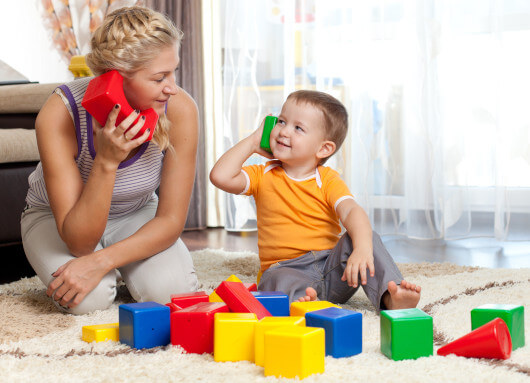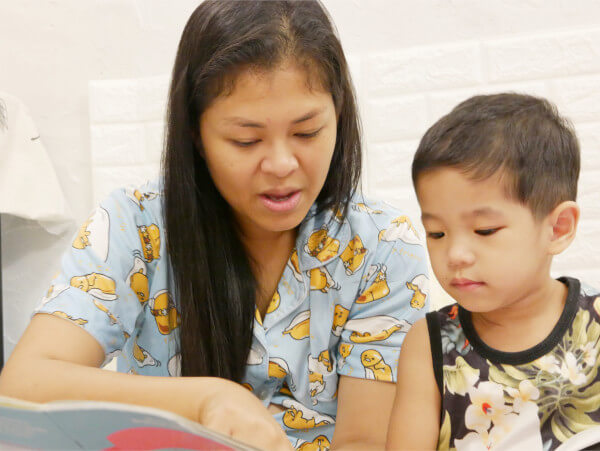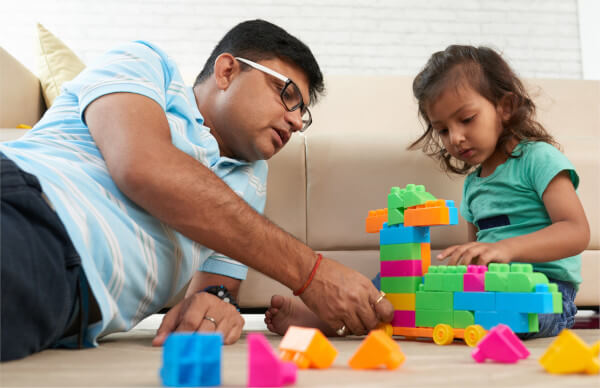Intervention Choices
Choosing the right Autism Intervention for your family
What is RDI?

Relationship Development Intervention (RDI) is a research-based, relationship-focussed autism therapy developed by visionary clinical psychologists, Dr Steven Gutstein and Dr Rachelle Sheely in the early 2000’s.
RDI focuses on the parent-child guiding relationship as the foundation for developing social, emotional and practical skills. It also builds communication and dynamic thinking to improve the quality of life of children, teens and adults on the autism spectrum.
“RDI is more than a therapy – it’s a way of life.”
Is RDI right for my family?

RDI may be right for your family if you:
- have a new diagnosis of autism spectrum disorder and want your daily interactions to make a difference
- are not getting the type of results you had hoped for with current interventions
- are seeking an intervention that focuses on how autism affects thinking, communication and behaviour, rather than treating delays in specific skills
“Everyone’s personal preferences and circumstances are different. RDI won’t be feasible for everyone, but we are eager to help you find out what suits your priorities and lifestyle.”
How does RDI work?
RDI is a way of life rather than a traditional therapy. RDI focuses on the parent-child guiding relationship as the foundation for the child, teen or adult’s social and emotional development. (RDI is appropriate for all ages but we will use parent/child wording and examples for simplicity.)
RDI consultants help parents pay attention to developing the child’s initiative, motivation, persistence and sense of competence. They show parents how to frame situations to facilitate their child’s success while providing an appropriate level of support and a just-right challenge.

Through RDI, parents learn how to model responses and scaffold interactions to enable their child to learn to interact with them with growing competence. This mindful parent-child interaction is a vital foundation for children with autism. It develops their awareness of others so that they will be able to gradually relate with peers, who are typically more unpredictable and harder to “read” than parents who know their child’s readiness and adapt accordingly.
The process and the interaction are the focus in RDI, not the end result. Mistakes and obstacles are learning opportunities. Learning is experiential and, like in typical development, the child with autism’s skills grow as a natural flow-on from observing and copying others. Skills fall into place more readily when they can appreciate others’ perspectives and seek and accept their guidance.
When guided using RDI principles, children, teens and adults who have ASD develop initiative and the motivation to seek their own growth. Their awareness of self and others grows and they start to share their experiences rather than recounting facts or events. Other restrictions imposed by autism also begin to fade as they use past experiences to guide their actions. The reliance on sameness and black and white thinking reduces, so children grow to be more flexible and able to solve increasingly complex problems independently. Over time, they can learn to manage uncertainty and respond to new information, enabling dynamic communication and reciprocal relationships. Even during this growth process, there is greater quality of life for the whole family.
“We love explaining what RDI is, but until you start using it it’s hard to grasp how different it is from other interventions.”
The RDI process: assessment, intervention, review
RDI supports parents to set the stage for learning to occur. RDI can take place anywhere and any time during daily activities. You don’t set aside hours and hours to provide repetitive practice.

The RDI process starts by recording baseline videos of parents or caregivers interacting with the child using the RDI assessment protocol. The videos are carefully reviewed to assess the extent of joint attention, coordination, collaboration, communication, guidance, responsiveness and awareness, and to identify any obstacles that could impede progress.
The consultant tests her hypothesis for initial intervention with the child herself then discusses this with parents before determining their first assignment goal and uploading this to their private section on the RDI Learning Site.
Parents are their child’s primary guides. Coached by their consultant, they become aware of opportunities for growth in the course of their day and use specific assigned concepts to promote their child’s development. This helps fill developmental gaps and facilitates new brain pathways.

Fortnightly videos of their interactions provide the opportunity for parents to review how they implement strategies and consider what is working well as well as areas for refinement. The consultant reviews the videos and uses these and discussion with the parents/teen/adult to individualise goals and strategies and determine the next goal.
The consultant is also guided by detailed social and emotional developmental steps provided in the RDI Program which is informed by current research in learning, brain development and function, child development and social and emotional development.
RDI typically requires a commitment of around 1 hour a fortnight for a meeting with the consultant and 2 hours a fortnight for uploading and reviewing videos, writing comments, and reading or viewing information. It takes about 12 months of consistent application to incorporate the main principles of RDI, but many families continue to work with their consultant for several years.
What are the limitations of RDI?
RDI may be limited by parents’ availability, their readiness to change how they operate within the family, their ability to be mindful to use daily opportunities and slow down, and whether they feel ready to be the ones to steer their child’s growth and take responsibility for their child’s development.
RDI may be easier initially if parents already have some computer/tech skills.
RDI is not yet well known with few certified consultants.
A note about research

Research indicates that RDI is a promising intervention for people of all ages with ASD and can help them become more connected with others and enjoying an improved quality of life.
However, the research on RDI is still in in its early stages so it can be difficult to compare different therapies based on their research base. Also, due to its focus on relationships, flexibility, dynamic thinking, and self-esteem, the outcomes of RDI are more complex to measure than the outcomes of a more behaviour-focussed intervention.
Parents considering different intervention options should focus on research which measures the types of results they are seeking, rather than the intervention which has attracted the most research. All families are different and there is no single autism intervention that suits everybody.
“Everyone’s strengths, challenges, preferences and circumstances are very different, so choose what suits your child and your family best.”
How to Compare Intervention approaches
Our aim is to use the following comparisons as a way of explaining what RDI is and isn’t, since that is what we know, rather than describe the alternative approach. We also hope that this will provide you with a template of aspects to consider when you research other interventions. Some RDI Consultants have been Applied Behaviour Analysis (ABA) therapists before they discovered RDI so they are in a reasonable position to explain how RDI differs from ABA . However, we realise that there are many variations of ABA, and it is not a specific therapy itself. It is range of different strategies and techniques to teach people with ASD new skills and reduce their difficult behaviour.
How do RDI and ABA approaches differ?
Perspective on Autism Spectrum Disorder (ASD) and Remediation
ASD is a neurological disorder affecting the way the brain is wired.
The focus is on providing important developmental milestones in social and emotional awareness that were missed early in life, due to the growth-seeking drive being diminished by ASD.
ASD is a behavioural disorder, the origins of which aren’t as relevant as how to change the result.
The focus is on modifying behaviours by influencing the child’s physical and social environment.
Overarching Principles
The typical parent-child “dance” or feedback loop is interrupted in autism. It is fundamental to restore the guiding relationship with the parents/carers so the child develops trust and feels safe, rather than being in a continual struggle to be in control.
Reduce the demands on children with ASD by coming alongside the child and fostering a sense of togetherness, support and invitation.
Teach specific steps to build the child’s social skills, self-care skills, communication skills, play skills and behaviour.
Scaffold learning using prompting and instruction with reinforcers to train the child to respond and act appropriately and reduce difficult behaviour.
Goals of Intervention
Develop awareness of others, dynamic reciprocal communication, problem solving and flexibility so that the person and their family can enjoy a good quality of life and caring relationships.
Foster ability to adjust when faced with change and complexity.
Develop specific life skills and learn to generalise them to enable learners to become independent and successful now and in the future.
Development of visual referencing
Eye gaze (we refer to it as facial referencing) is developed by providing necessary and meaningful reasons to look to a parent for information – a “what do I do now” or “is this ok with them” look. It is important that the parent respond with strong face expression and appropriate follow through, so the child learns that there is great value in “reading” someone’s face.
Eye gaze is developed by the parent or therapist by drawing attention to their eyes, either by saying “Look at me”, or by holding an item near their eyes, calling the child’s name, or moving in front of the child’s eyes. The child’s gaze response is then reinforced with social praise and access to a fun activity.
Perspective on difficult behaviour
Whether it is scripting, aggression, a tantrum or avoidance behaviour, look for the feelings and reason behind it, as children do the best they can.
Most of the time the child is feeling overwhelmed, threatened or confused so seeking control. so we modify expectations e.g. slow down, simplify, decrease language.
Develop the child’s sense of competence and connection and the parents’ ability to be the calm in their child’s storm.
The parent/carer’s role is to adjust expectations to help the child feel safe and to develop trust in their guidance so they feel secure and their distress is heard.
Observe, notate and modify what happens before and after behaviour in order to create effective behaviour change.
For undesirable behaviour, the therapist will act to reduce the likelihood of it happening again by ignoring, using time-out, redirecting, moving on, removing a token, giving an x on a behaviour chart, overcorrecting, or taking away a desirable toy or activity.
Qualifications
Consultants are trained and certified by RDI Connect.
They often have a degree and experience in allied health or teaching and/or they may be parents of a child with ASD.
There is a requirement for ongoing professional development to qualify for annual recertification.
Practitioners don’t need formal qualifications to practise ABA therapy in Australia, but there is an international certification board – the Behaviour Analyst Certification Board.
Therapists are usually supervised by a psychologist with extensive training in ABA.
A practical example – cleaning teeth using RDI or ABA

RDI approaches cleaning teeth as a way for parent and child to connect with each other.
With little children, we’d have the child standing on a step to be closer to dad’s height so they can be face to face. There would be no verbal prompting about the process. It would happen largely without words, but may include a few fun and timely sounds. Dad might get his brush and hold it with a quizzical look on his face and look at his son.
He might then get the toothpaste (if his son doesn’t get the hint) and hold it out to his son to take off the lid (presuming he can) Then he might hold his toothbrush near the toothpaste to see if his son will squeeze some on for him. Dad would be making sounds and expressions to encourage his son’s engagement with him and make this fun.
Next dad might accept the toothpaste and prepare to put some on his son’s toothbrush – but his son isn’t holding his toothbrush yet, so either son gets the hint, or dad might put toothpaste on his son’s finger instead.
When they are both ready with their toothbrushes, dad will open his mouth wide to show his teeth and slowly apply the toothbrush, grinning and using his eyes to engage with his son. The son might just watch, or he might decide to do what dad does.
He won’t do it quite the same as dad, but that isn’t what dad is aiming for. He’s using this time to connect and have fun, making toothbrushing a together time, rather than a chore to learn.
They might have fun trying to spit out at the same time when they’ve finished, with dad dramatically puffing his cheeks out trying not to spit out until his son is ready. They might even have a go at taking turns to clean each other’s teeth, if his son’s teeth need some adult attention.
Although the goal wasn’t learning to brush teeth, the son is keen to do what dad does and enjoy his company, so he learns the skill in the process and they have lots of interaction and fun as they go. The parent will often set up a video recorder on a tripod unobtrusively and record short interactions with their child so that they can review what they were doing and their child’s response, so they can adjust what they do next time. They also share relevant videos with their consultant via an online learning platform.
The ABA approach would focus on teaching the child all the steps involved in cleaning teeth: getting the toothbrush; getting toothpaste; opening toothpaste; putting a small squeeze of toothpaste on the brush; putting lid back on toothpaste; putting toothpaste back; practising brushing up and down; spitting out; turning on the tap; rinsing the mouth; and rinsing the toothbrush.
Throughout the process the son would receive prompts, support and praise for the steps that are easiest for him and be verbally prompted and physically assisted for the rest. The parent would record the steps that were done independently and which ones assisted and probably end the task with a high five or “good job”. Following those steps and gradually gathering more independence in doing all the steps correctly and effectively is the goal.
Can I use RDI and ABA together?
Usually – no, it would be too confusing for the child and impede their progress. While both RDI and ABA have some overlapping intervention goals, they operate from very different principles and use different methods.
With ABA the child will typically be given verbal (and sometimes physical) prompts and a structured stepped procedure to achieve a specific skill. They will be reinforced for compliance. The focus is on practising a particular behaviour or living skill and it uses and encourages static thinking.
With RDI the focus is on the process – how the brain is activated, thinks about and organises what’s happening and the child’s interaction with others. This makes it a flexible and dynamic process.
Further Autism Resources
Choosing an intervention
These sites may be useful as a starting point but be aware that the information on specific interventions may not be up to date. The information they provide is not accurate for RDI and could be inaccurate for other therapies.
- Aspect’s NSW site provides Choosing interventions decision chart.
- The Raising Children Network also provides information about choosing services. This site also provides an A to Z guide with information about each type of service.
Intervention Approaches
This list has been adapted from A review of the research to identify the most effective models of practice in early intervention of children with autism spectrum disorders by Prior, M., Roberts, J. M.A., Rodger, S., Williams, K.& Sutherland, R. Published in 2011 by the Department of Families, Housing, Community Services and Indigenous Affairs, Australia.
Comprehensive Programs
- ABA Australia Overview of applied behaviour analysis
- Autism Behavioural Intervention Association: ABIA Overview of ABA
- Applied Behavioural Analysis Programs
- Early Start Denver Model (ESDM) ABA plus some developmental programming
- TEACCH Treatment and Education of Autistic and Related Communication Handicapped Children – uses a very intensive, structured teaching approach
- LEAP Learning Experiences and Alternative Program for Pre-schoolers and Parents – uses classmates at preschool to teach social skills
- SCERTS Social-Communication, Emotional Regulation and Transactional Support*.
- DIR/Floortime Approach Developmental, Individual-differences, & Relationship-based model
- RDI® Relationships Development Intervention
- The P.L.A.Y. Project® Play and Language for Autistic youngsters
Service Based Treatments Specific to Autism
- PlayConnect Facilitated playgroups for young children with ASD
- RDI® Relationship Development Intervention
- Hanen ‘More than Words’ Training parents to help children with autism spectrum disorder (ASD) develop communication skills
- Pre-schoolers with Autism Manualised parent training program
- Triple P – Stepping Stones adaptation Positive parenting strategies for children with a disability
Therapy Based
- Speech Generating Devices (SGD) and other Augmentative & Alternative Communication (AAC)
- PECS Picture Exchange Communication System
- Signing
- Alert Program for self-regulation
- Social Stories
- Pragmatic Language Groups
- Aquatic OT Programs Autism specific (example only)
- Cognitive Behaviour Therapy
- Phonological Awareness/Literacy Groups
- Sensory Integration Therapy
- Sensory Diet
- Multi-sensory Environment
- Auditory Integration Therapy
- Fast ForWord Program
- PROMPT Prompts for Restructuring Oral Muscular Phonetic Target
- HANDLE®
- SSP – Safe and Sound Protocol Listening program to reduce stress and auditory sensitivity while enhancing social engagement and resilience
Single Element Components Addressing One Aspect of ASD
- Sleepwise© Positive Sleeping Practices for Young Children with Developmental Delay
- PALS Social Skills Program Playing and Learning to Socialise
- Toilet Time© – Toilet Training for Young Children with Developmental Delay
- Music therapy (when autism specific)
- SoSAFE! (not relevant to early intervention age-group).
- “Social Eyes”
- Secret Agent Society Computer games for social and emotional skills
Other Autism Information
- Autism Awareness Australia
- Autism Association of Western Australia
- Autism Association of Tasmania
- Autism Northern Territory
- Autism Association of South Australia
- Autism Association of Queensland
- ASPECT (NSW)
- Irabina Autism Service (VIC)
- Autism Alliance (WA)
- Amaze (VIC)
- Autism Cooperative Research Centre
- Positive Partnerships Planning Matrix of individual strengths and needs for use in school settings
Books about or related to Relationship Development Intervention
- The RDI Book – Forging New Pathways for Autism, Asperger’s and PDD with the Relationship Development Intervention Program by Steven E. Gutstein
- The Relationship Development Intervention (RDI) Program and Education by Steven E. Gutstein
- My Baby Can Dance – Stories of Autism, Asperger’s and Success through the Relationship Development Intervention (RDI) Program Edited by Steven E. Gutstein, Hannah R. Gutstein & Carlotta Baird
Background reading related to Relationship Development
- Apprenticeship in Thinking Barbara Rogoff
- The First Relationship: Infant and Mother Daniel Stern
- How Children Learn the Meaning of Words Paul Bloom
- Joint Attention: Communication and other Minds Elian, Hoerl, McCormack, & Roessler
- Emotional Development: The Organization of Emotional Life in the Early Years L Alan Sroufe
- Developing Through Relationships: Origins of Communication, Self and Culture Alan Fogel
- Constructing a Language: A Use-Based Theory of Language Acquisition Michael Tomasello
Autism Handbooks
- The Autism Discussion Page on the Core Challenges of Autism – A toolbox for helping children with autism feel safe, accepted and competent by Bill Nason
- The Autism Discussion Page on Anxiety, Behaviour, School, and Parenting Strategies – A Toolbox for helping children with autism feel safe, accepted, and competent by Bill Nason
Families’ Journeys
- Love Tears and Autism by Cecily Paterson
- A Child’s Recovery from Autism by Hanna Rotbaum